Menu
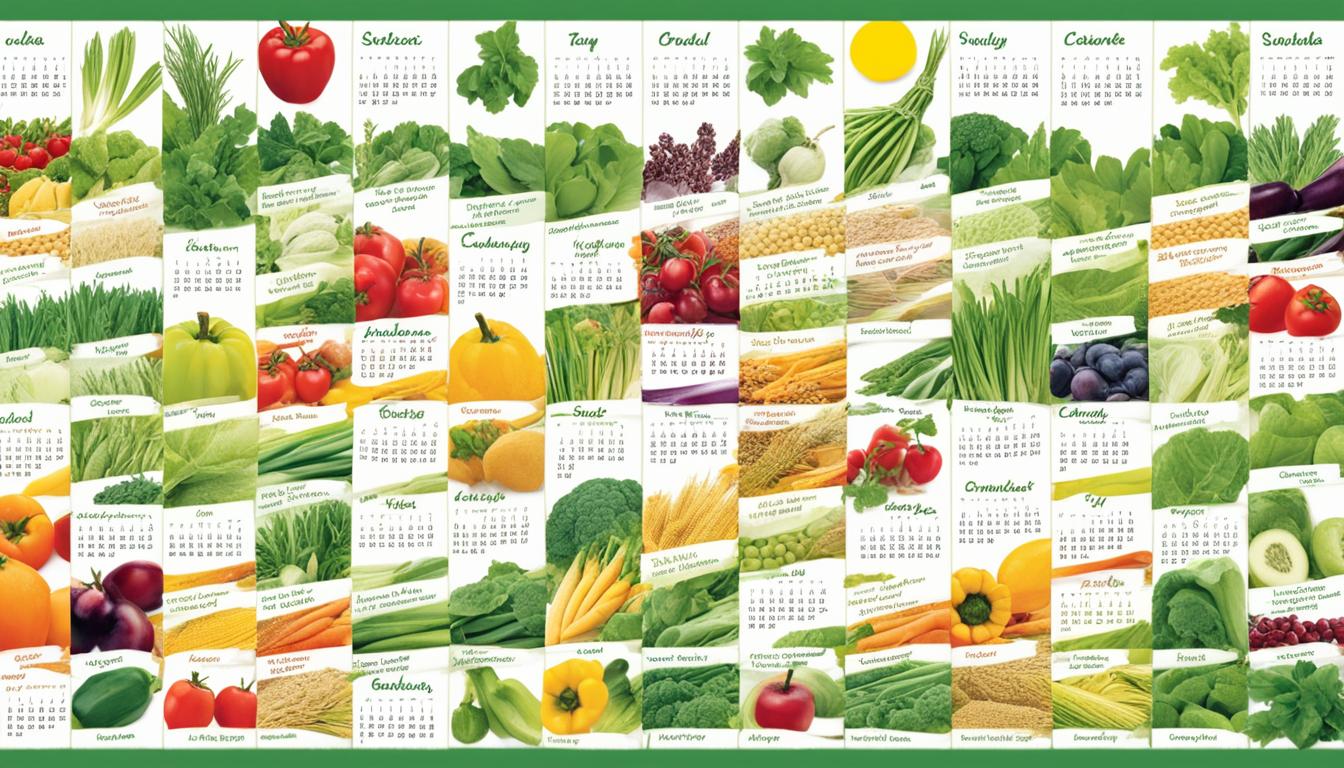
Did you know that the New York State Department of Agriculture and Markets has a great harvest calendar? It’s available in many languages, like Bengali, Russian, and more. This guide, along with FoodPrint’s Seasonal Food Guide, tells you when fruits and veggies are in season. It’s really useful for getting the most out of your farm all year round.
I will share all about the main parts of the farming year and what to plant when. You’ll learn the best times to grow things like asparagus, broccoli, or strawberries. Knowing this helps keep a healthy diet every season. The weather in each area affects what you can grow. You can enjoy these foods fresh, frozen, or other ways.
For farmers, a seasonal calendar is like a best friend. It helps decide the best times for planting and harvesting. This means the farm gets just the right weather for the crops to grow well. The calendar makes everything from planning to working on the farm more efficient.
Imagine a carefully made list showing when to do different farm activities. This list includes when it will rain, which crops will be ready to eat, how busy the farm will be, crop prices, and the money the farm makes. With this list, farmers can choose the perfect time to grow their crops.
| Variable | Description |
|---|---|
| Rainfall Patterns | Tracking seasonal rains crucial for irrigation planning. |
| Food Availability | Ensuring a steady supply of food based on harvest cycles. |
| Non-Agriculture Workload | Balancing other livelihood tasks with farming duties. |
| Crop Prices | Monitoring market trends to optimise profitability. |
| Household Income | Aligning agricultural activity with income stability. |
Following the farm calendar is key for many reasons. It matches what the farm does with the changing seasons. This lowers the chance of crops getting harmed by bad weather, like an early frost. Also, it helps crops grow the best by planting them at the right time.
Doing the calendar is also a good chance for farmers to talk and plan together. They look at how different farm tasks change all year. Combining this with tools like the People’s Map or Transect Walk makes farming stronger and better prepared.
Using these detailed tools helps farms run better. It’s not just about planting and picking the crops. It’s about working with nature’s cycle to get the best farm results.
Getting ready for spring planting plays a big part in a good harvest. Having a clear plan for planting helps the crops grow well.
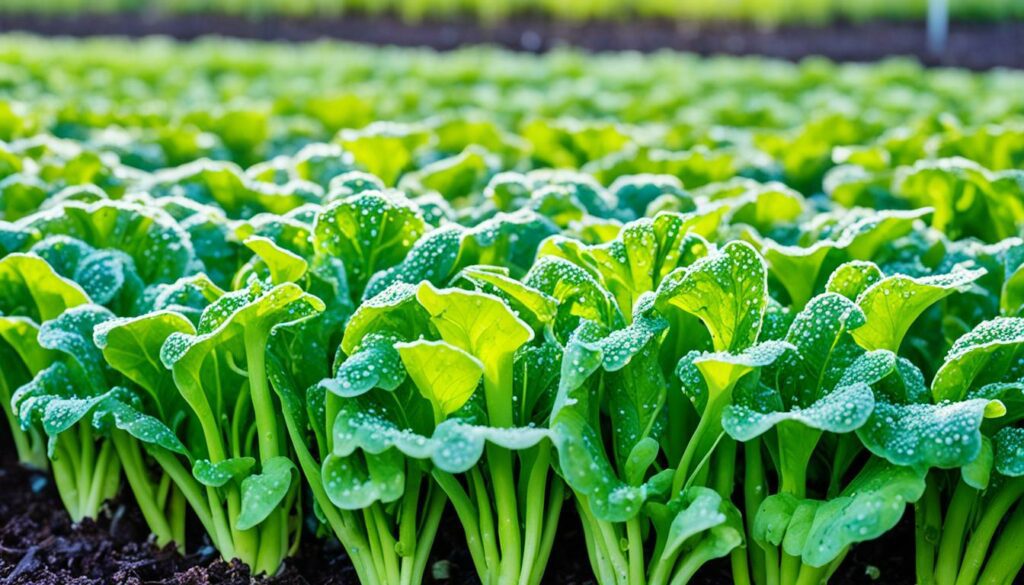
Choosing the right crops for a cool, early spring is key. Lettuce, peas, and radishes grow well in these conditions. So do broccoli and cabbage. Don’t forget to check your soil to make sure it has what these crops need.
Knowing when to plant is important for a good harvest. In northern Utah, the last frost is usually around Mother’s Day. Use this as a guide for your planting dates.
Start planting cole crops as early as Valentine’s Day to give them lots of time to grow. A few weeks later, it’s time for root vegetables. Make sure to check the soil’s moisture as they start growing.
| Crop | Recommended Planting Date | Key Notes |
|---|---|---|
| Cole Crops (e.g., Broccoli, Cabbage) | Valentine’s Day | Early planting helps the most |
| Cool-Season Root Vegetables | 2-3 weeks after cole crops | Check soil moisture |
| Garlic | October or November (previous year) | Gets ready for spring growth |
Using IFA’s Grand Champion All-Purpose Fertilizer or IFA’s 16-16-8 Premium Garden Blend Fertilizer helps your plants every six weeks. It’s also smart to keep good notes on how your plants do. This helps you do better next time.
In the summer, farming faces tough challenges. But, it also brings chances to make crops grow well. It’s key to pick plants that like the heat and manage soil and water. This helps keep your crops healthy, even when it’s very hot, and ensures a good harvest.
Choosing heat-proof crops is vital in the summer. Varieties like tomatoes, cucumbers, and beets do well in the heat. They keep your farm productive in tough weather. For instance, planting sweet potatoes in April-May lets them grow strong roots before the hottest times.
Great soil and using water well are essential in summer. July to September is a key time for farming. Making the most of the water you have is critical. Systems like irrigation and mulching keep your soil moist and shield crops from heat. Also, check soil pH often to ensure plants get the nutrients they need.
Farming in summer includes many tasks, from planting to using fertilisers. All efforts help keep your fields healthy and productive. Using good soil strategies and picking the right plants tackle summer farming’s challenges for a good harvest.
Here are the best times to plant different crops in summer:
As autumn arrives, the scenery shifts. The cool air signals it’s time for *autumn planting*. This period is perfect for growing hardy vegetables. The cool temperatures are ideal for their development, especially with the right *soil preparation*.
In many places like the Piedmont and coast, certain crops thrive in autumn. These include *potatoes*, *garden peas*, *radishes*, and *turnips*. You can also plant *broccoli*, *cabbage*, and *kale* now. It’s smart to start *green beans*, *carrots*, and *zucchini* eight weeks before the first frost arrives. This planning helps them grow well till it’s time to harvest.
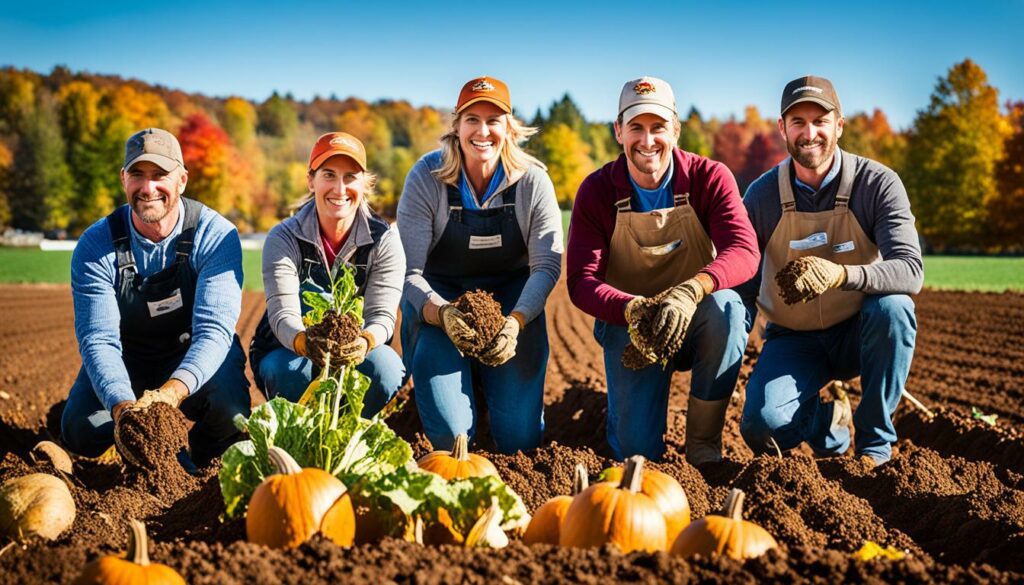
Getting the soil ready is key for autumn planting. After the summer, the soil needs a boost to help new plants. Adding compost improves the soil, helping it to hold water and nutrients. This helps the plants grow better and prepares the soil for winter. Also, doing a soil test can tell you what the soil needs. This makes your *autumn planting* preparation just right for a good harvest.
Good winter crop planning is vital for a successful growing season in cold weather. Choosing crops that can survive winter and protecting them from frost are crucial. These steps help keep growth steady and yields high during cold months.
Choosing the right crops for winter is key to a solid plan. Vegetables such as spinach, kale, and Brussel sprouts keep growing even in frost.
Use information like Days to Maturity from seed companies to plan well.
Planting at different times, from every 7-10 days to 2-5 days, leads to a longer harvest. Crops like cabbage, collards, and kale can provide fresh veggies until December. This extends the growing season.
Protecting crops from frost is essential. Using high tunnels to move crops indoors, especially the delicate ones, helps. Additional growing of certain crops in late winter, in areas once used for harvest, is a smart step.
Cold frames and unheated tunnel houses can keep less tough crops going, like broccoli and lettuce. It’s important to watch the crops and make changes if needed. This includes adding more seeds or making new plans based on how the season goes.
To wrap up, smart winter crop planning and careful frost protection are essential for a good farming year. These practices keep crops growing well in the coldest months.
A well-thought-out crop rotation schedule is key to keeping farms sustainable. It helps keep the soil rich and control pests and diseases. This method makes it easier for crops to grow well over time. Now, let’s learn more about how this works and the benefits it brings.
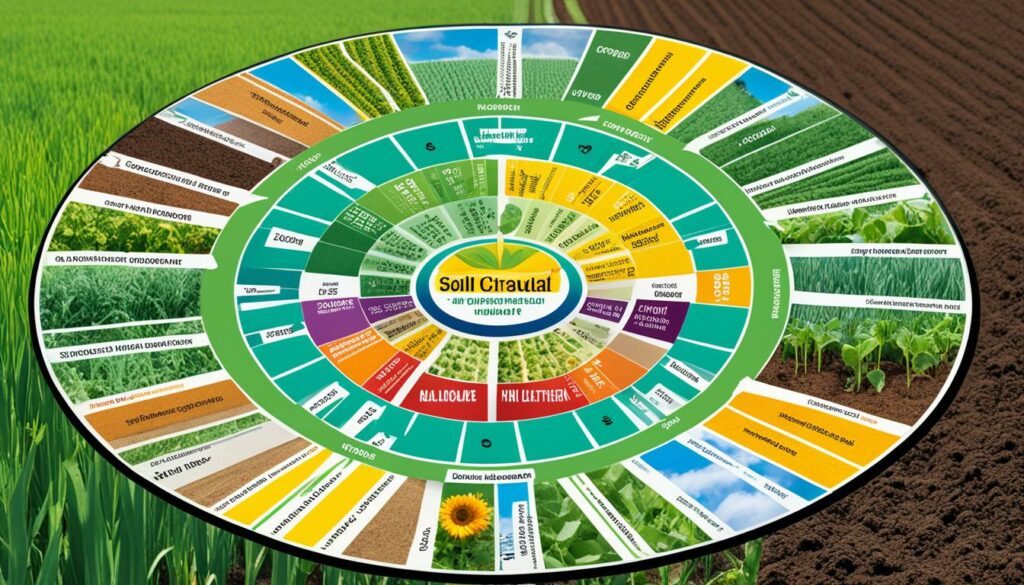
To rotate crops, you plant different ones in the same area each year. At Small Valley Farm, they wisely mix up crops like Tofu soybean, Corn, and Oat/clover/spelt. They do this over 120 acres every year. This mix helps keep the soil healthy by not pulling out the same nutrients every year. It also makes it hard for pests to settle in because there’s always something new for them.
Rotating crops has a bunch of good points. It’s great for the soil, like swapping out different nutrients. Small Valley Farm makes sure to use enough nitrogen in their rotations to keep things balanced. This method also cuts down on diseases that might attack plants of the same kind. With careful planning, these problems can be dodged.
| Crop | Year 1 | Year 2 | Year 3 | Year 4 |
|---|---|---|---|---|
| Bed A | Tomatoes | Sweet corn | Okra | Beans |
| Bed B | Sweet corn | Okra | Beans | Tomatoes |
| Bed C | Okra | Beans | Tomatoes | Sweet corn |
| Bed D | Beans | Tomatoes | Sweet corn | Okra |
Adding cover crops like buckwheat helps farms stay healthy for longer. Buckwheat stops weeds and keeps the soil full of nutrients. What’s more, it avoids letting pests get too comfortable by changing crops every few years. This one step helps a lot to keep the farm going strong.
It’s key to know when to plant to get the most from your crops. While some rules are good to follow, it’s important to know what your area needs. Different hardiness zones mean different planting and harvesting times.
The USDA breaks regions into hardiness zones by winter temperatures. This helps us know when to plant. For example, you should start growing broccoli indoors from February to March. Then, move them outside in April. But, warmer places might have different times for this.
| Crop | Indoor Planting | Transplant/Direct Seeding |
|---|---|---|
| Asparagus | – | Mid-March – Mid-April |
| Beans, Lima | – | Mid-May – Mid-July |
| Beets | – | April – July |
| Broccoli | February – March | April |
| Brussels Sprouts | May | Mid-June – Mid-July |
| Cabbage | Mid-February – Mid-March | Mid-March – Mid-April |
When making your planting calendar, look at your hardiness zone. This ensures your crops go in at the right time. For example, lettuce seeds indoors in July means a fall crop. And you can plant carrots in two batches, from April to July.
Knowing about your regional planting schedules means you can adjust certain guidelines. This helps you make the most of your land and keep your farming sustainable.
Agricultural technology stands at the front of making farming better. With fewer resources and climate change, using new tech is key. It allows farmers to plant at the right times, making their schedules better. This boosts how much they can grow. Studies show they can make more food – up to 15% more – by planning right.
Tools like the EPIC model have changed how we grow grains. They help us understand when to plant to get more with less water. This is very important in hot areas like India, where water is a big issue.
China’s National Natural Science Foundation-backed research shows planting early can lead to big harvests. By changing when they sow crops like rice and wheat, they got much more than usual. Optimising their calendars made this possible, fighting against lower yields because of warmer weather.
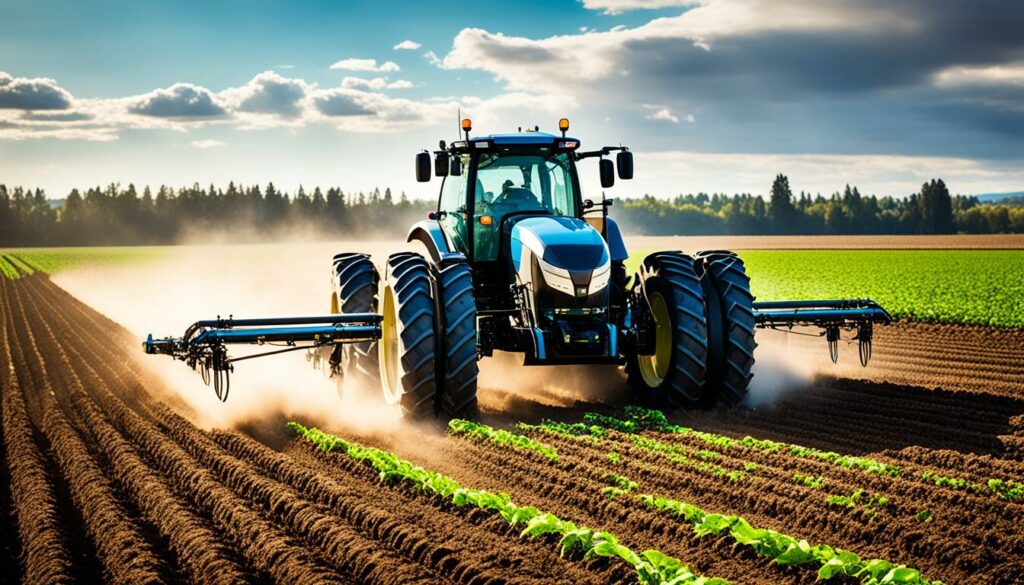
Ending hunger and food insecurity by 2030 is a big aim. To achieve this, it’s vital to time plantings well. This is a key strategy to either avoid or fix low yields. Using tech to better plan planting helps farms be more efficient. This is important to meet the world’s food needs. Plus, it helps fight food shortage caused by climate change.
Maximising what you grow is about smart harvesting. It’s key to know when to harvest to get the freshest crops. This guide helps match your harvesting time with crop growth and what the market wants.
Using the right methods to pick your crops matters a lot. Clean cuts with sharp tools are a must. This keeps the plants healthy for the next round of growth. Being careful with how you handle crops, especially soft ones like strawberries and blueberries, helps avoid damage.
Finding the right time to pick can really boost how much crop you get. Harvest calendars give a good idea when to expect fruits and veggies. But, remember, these times might change by a couple of weeks because of the weather.
Harvesting is a bit different in places like Alabama compared to California or New York. It’s important to watch the weather in your area. This ensures you pick your crops when they’re the tastiest.
The best times to harvest also depend on where you are in the world. Canada, Australia, and France all have their own special timelines. By adjusting when you harvest based on where you are, you can get more crops.
Starting a journey into farming can be very exciting but also overwhelming. For beginners, it’s key to understand the basics of when to plant. This planting season guide is essential for getting your timings right. It helps you know when to plant for the best harvests. By planning with expert advice, you can dodge many common mistakes.
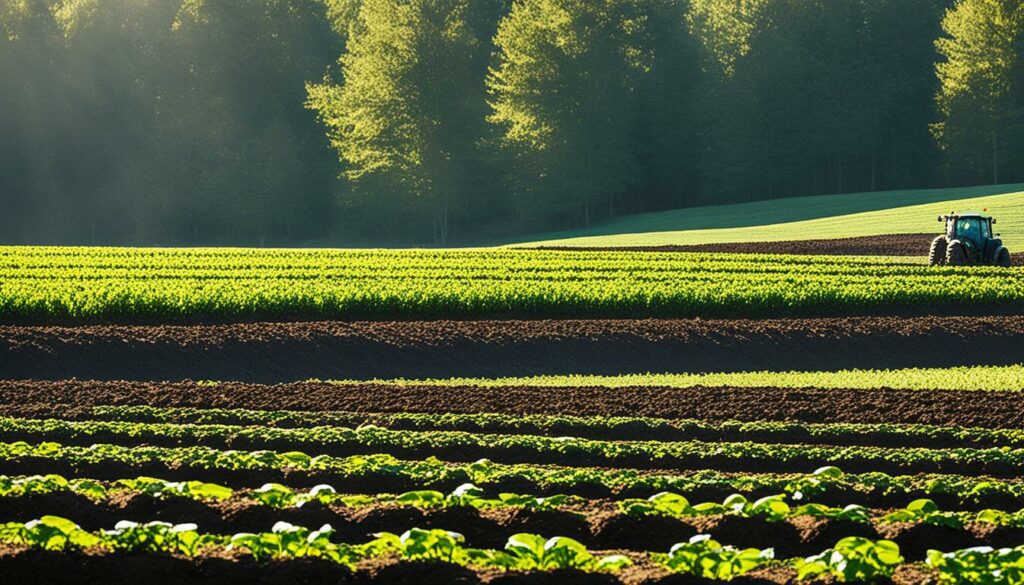
When you’re beginning, focus on the hardiness zones in your area, like those set by the U.S. Department of Agriculture. In Virginia, you’ll look at zones 6a, 6b, 7a, 7b, and 8a for the best advice. Following these guidelines tells you the best times to plant for a good harvest. You can also lengthen your growing season with tools like row covers and cold frames. These tools make it possible to plant and harvest 2 to 4 weeks longer in spring and autumn. Make sure to use resources like the “How Much to Plant” chart. It gives you all the details you need, from how far apart to plant things to how much you can expect to harvest. It’s a great help for planning your garden based on your family’s needs.
Learning about common mistakes in farming is vital for beginners. Many new farmers overlook their local weather conditions, like average temperatures and humidity. Picking plants that don’t suit your zone can mean a bad harvest. Timing is also key. Plant and harvest your crops within the right 10-day window to avoid weather surprises. Succession planting, where you plant new crops every few weeks, is crucial for a continuous harvest. Lastly, choosing the right plant varieties is also essential. Always check with local experts for tips on plants that are tough against pests and diseases. They’ll be marked with labels like “V”, “N”, “F”, or “T”. Avoiding these mistakes improves your chances of success in farming.
Following these tips can make starting your farm much smoother. Taking care to avoid common farming mistakes leads to a more enjoyable and fruitful farming journey.
Herbs are more than a tasty add-on. They’re a key part of a good farming plan. They work well with what grows each season. I’ve farmed in Oregon, Missouri, and Vermont. Along the way, I’ve learned a lot about growing herbs. These tips are useful for all farmers, new and old.
Choosing the right seasonal herbs helps your garden grow. Here’s what you should plant each season:
| Season | Herbs |
|---|---|
| Spring | Parsley, Chives, Cilantro, Dill |
| Summer | Basil, Oregano, Rosemary, Thyme |
| Autumn | Sage, Mint, Coriander, Fennel |
| Winter | Chervil, Coriander, French Tarragon, Cress |
Your herbs need a lot of love to do well. They love sun, at least six hours a day. A soil that’s not too acidic or basic is best.
Holding off too much water is important. Make sure each herb is in the right spot. Some, like mints, can take over if you’re not careful.
Don’t forget to trim your herbs for growth. Depending on the time of year and what you need, you can pick a lot from each plant. You can also dry or freeze herbs for later. Remember, not all herbs like wet weather. Keep an eye on those ones.
With these tips, your herb garden can really shine. Herbs work well with your other plants or can be the star on their own. They add real value to your farm all year.
Learning what fruits and vegetables are in season is key. This knowledge helps us enjoy better taste and nutrition all year. We’ll look at how different fruits and vegetables are grown and how this affects our health.
Every month, we get a variety of seasonal produce. In April, for example, we see asparagus, carrots, crab, and new potatoes. Then, in the summer—July and August—we get peaches, tomatoes, and more. Later, in October and November, vegetables like beets and Brussels sprouts are at their best. Finally, in January and December, we enjoy citrus fruits.
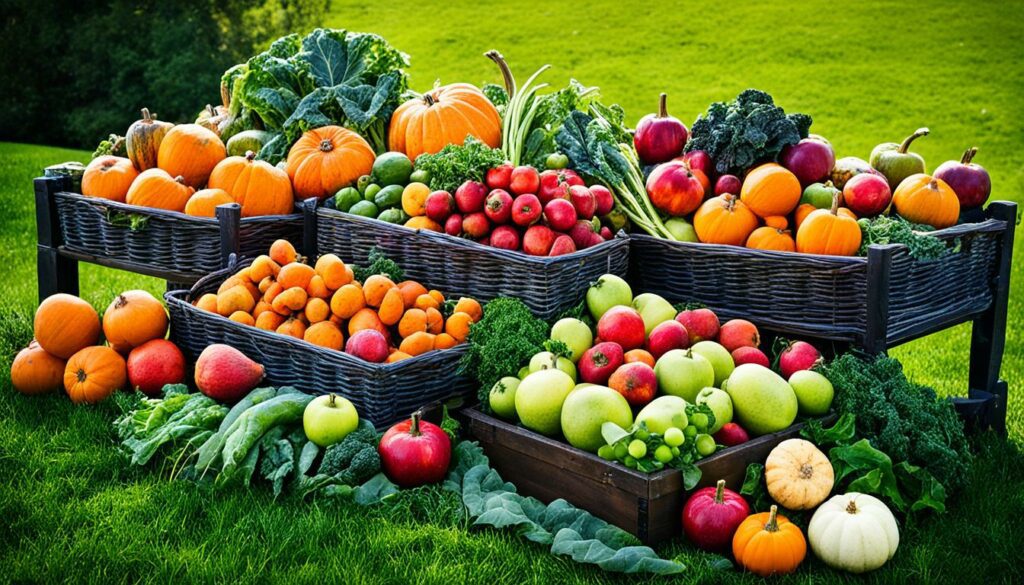
June and July offer the most variety, with fruits and vegetables like apricots and zucchinis available. In September, we move to wild mushrooms and root vegetables. This shows how the variety changes throughout the year.
Choosing seasonal produce means farmers can grow better food. They pick crops that thrive in each season’s weather. This boosts the taste and health benefits of the food. Vegetables, for example, have more vitamins when they’re in season.
Using crop harvest calendars is smart for keeping fresh produce in stock. These calendars help with planning. They ensure we have fresh food to enjoy all year. And for too much produce, we can learn to store or can it properly.
Following seasonal farming is great for taste, health, and the environment. It supports a diet that’s good for both us and the planet.
Effectively managing planting cycles is key for efficient farming. It’s best to plant at different times. This way, a constant flow of blooms is ensured. Doing so helps farmers avoid large harvests that can lead to wasted produce. For example, planting a large number of seeds at once can mean you only start picking flowers in June. This creates a very busy period where farmers have to work relentlessly. This rush can lead to a lot of flowers going to waste because there are too many to handle.
Extend the flower season through staggered planting and cultivating multiple varieties that bloom at different times. This strategy evenly distributes the workload into more manageable waves.
Farmers can plan their plantings by noting the days it takes for seeds to become flowers and frost dates. Choosing crops with various growing times helps spread work more evenly. For example, Calendula flowers in about two months, while Black Eyed Susans take about four. This means you can have different planting times during the season. Spreading out your fields into separate parts lets you plant small amounts each week. This doesn’t add much to your work during the whole season. Planning like this allows for cutting and replanting at the right times, getting two rounds of crops each year.
Knowing when crops flower and when to replant ensures you always have something growing. Different types of crops have different needs. Places with different climates also affect when you can plant. Warmer places might allow for more planting times in a year than cooler ones.
Some of the top annual crops include Basil, Cockscomb (Celosia), Cosmos, Dusty Miller, Fiber Optic Grass, Foxglove, Iceland Poppies, Sweet Peas, and Zinnias. For example, Fiber Optic Grass can bring in nearly $2,000 from a 4 by 60-ft bed over a month. This kind of success is due to planting it five times with three weeks in between. It shows how critical it is to keep planting to enhance earnings from profitable crops like Fiber Optic Grass and Foxglove.
In the end, managing planting cycles well can lead to steady production and a reliable market supply. It shows how using good farming methods can lead to success in agriculture.
Today, sustainable farming is key to ethical cultivation. It helps the environment, keeps money flowing, and is fair to everyone involved. These methods involve practices that benefit the earth and are light on our planet.
Seasonal farming focuses on cutting pollution and saving our vital resources. It involves doing things like saving water and protecting the soil. Choosing smart irrigation, like drip systems, can use less water and grow more crops.

Keeping the soil healthy is critical for long-term farming success. Methods include planting different crops each season, using cover crops, and controlling pests naturally. This approach not only improves the land but also reduces waste.
This farming type follows the guidelines set by FAO for better food production and a healthier planet. It tackles worldwide farm issues and supports farmers financially. This way, farming can be a win for everyone.
Looking ahead in farming means we must review each season carefully. This helps us see what worked well and what didn’t. By doing this, we can plan better for next time.
A proper crop plan includes income estimates, greenhouse schedules, and more. These help farmers check if they’re planning too much. Yet, it doesn’t offer details like which crop should go where.
Tracking actual dates and sizes is crucial for improving plans. It lets us make changes based on what worked best. This can make our farm more productive and efficient over time.
Getting ready for the next season starts early. Winter time is perfect for making detailed crop plans. Printing them on tough paper in spring means they’ll last. Using tools like Google Sheets helps keep everything organised.
It’s key to have a plan for planting, including when and where. Software like Tend.ag can be useful, even if it costs a bit. Also, remember to ask seed companies about how long their seeds need to grow.
| Planning Aspect | Action |
|---|---|
| Annual Gross Income Projection | Generate by crop |
| Greenhouse Schedule | Create & print |
| Direct Seeding Schedule | Create & print |
| Seed Ordering Checklist | Compile & consult DTM |
| Climate Variability | Adjust planting schedules |
| Real Life Actuals Data | Track & refine |
Planning for the future is vital in farming. These steps help us be ready for whatever comes. With the right plan, farms can keep growing and getting better.
Following a seasonal farm calendar is key to farming success all year. This plan makes sure every step, from planting to harvesting, is well thought out and done right. It helps get the best crops and the right time to sell.
The farming year has different busy times. For instance, late September to early December is all about harvesting and preparing the soil for next year. Winter lets farmers repair machines and plan ahead. In spring, it’s time to plant and make sure the fields are ready. Then, summer is for feeding the crops and keeping pests away.
The weather is crucial in farming. With a good plan based on local weather and new tech, farmers know the best times to plant and harvest. Special methods, like drip irrigation and choosing crops that fit the area, can boost harvests. A well-set farming plan helps manage resources better and keeps farming sustainable every season.
Farmers and gardeners use a Seasonal Farming Calendar to know when it’s best to plant and harvest. This method makes sure crops grow well, following nature’s rhythms. It also protects them from unexpected cold.
It’s vital because it ensures crops are grown and picked at the perfect times. This leads to better crops and avoids bad weather. This way, the harvest is protected from harm.
In spring, plants like lettuce and radishes do well. Peas and different greens also love the cooler weather. These choices can be planted over time to get lots of produce.
In summer, it’s important to keep the soil moist and cool. Mulch helps retain water, and good irrigation is key. Making sure the ground is airy also helps plants survive the heat.
Autumn is perfect for growing root vegetables like carrots. Leafy greens such as spinach are also great choices. These plants like the cooler days and can be picked before winter.
Some tough greens, like Brussels sprouts, don’t mind the cold. Winter cabbage and kale are also good at surviving low temperatures. They need little help to stay strong in winter.
Crop rotation keeps the soil healthy and stops pests. By changing what’s planted, the soil stays full of nutrients. This way, the land stays good for farming without using up all its resources.
Where you live affects when you should plant. Knowing about your local weather and soil helps you plan right. This means your crops will be planted at the best times for your area.
Modern farming tools can really help. They make it easier to know when to plant and harvest. This technology helps your farm run better all year round.
Knowing when crops are ready is crucial. Using the right tools and picking at the best time is also important. Harvesting at the right moment ensures you get fresh, top-quality produce.
Start by picking crops that suit your area. Learn the local planting times. Following a seasonal calendar and advice from experts will help you avoid mistakes.
Herbs match different seasons. Spring is perfect for parsley and chives. In summer, try basil and oregano. Rosemary and sage are great for autumn. For winter, thyme and mint are your best bets.
Growing a variety of seasonal fruits and vegetables is the key. This way, you get the most nutritious food. It’s fresh, tasty, and packed with vitamins and minerals.
Being kind to the earth in farming means crop rotation, composting, and using natural fertilisers. It also includes smart pest control. These ways keep the farm healthy and protect the environment.
First, look back on what worked this season. Then, prepare the land and choose the right crops. Organise a plan to ensure each step is taken at the best time for success in the future.